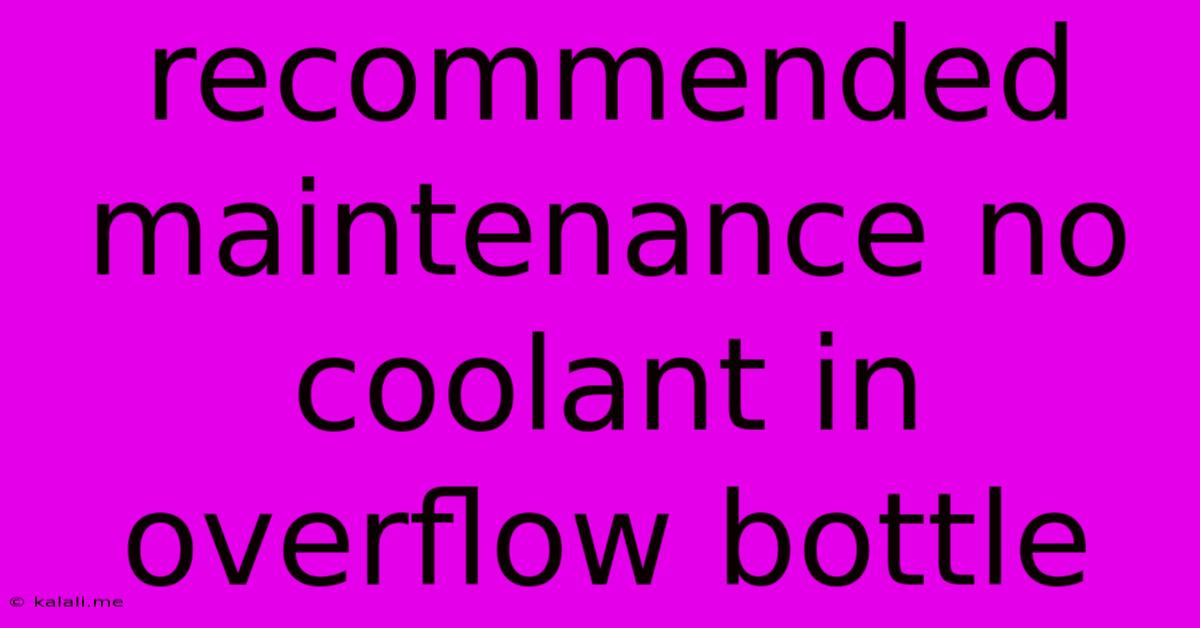Recommended Maintenance No Coolant In Overflow Bottle
Kalali
May 30, 2025 · 3 min read

Table of Contents
Recommended Maintenance: No Coolant in Overflow Bottle
Finding an empty or nearly empty coolant overflow bottle can be alarming. This seemingly minor issue could indicate a larger problem with your vehicle's cooling system. Ignoring it can lead to engine overheating and costly repairs. This article will guide you through understanding why coolant might be missing, and what steps you should take.
Why is My Coolant Overflow Bottle Empty?
A low coolant level in your overflow bottle isn't always a catastrophic event, but it demands attention. Several factors can contribute to a depleted coolant reservoir:
-
Leakage: This is the most common culprit. Leaks can occur anywhere in the cooling system, from small cracks in hoses or the radiator to a faulty water pump or thermostat. Look for signs of coolant leaks under the vehicle, particularly around the engine and radiator. Check hoses for cracks, bulges, or deterioration.
-
Head Gasket Failure: In more serious cases, a blown head gasket can allow coolant to leak into the engine's cylinders or oil. This will often be accompanied by other symptoms, such as white smoke from the exhaust, milky oil, or overheating.
-
Coolant Evaporation: A small amount of coolant evaporation is normal, especially in hot weather. However, significant evaporation points to a potential leak in the system, or a problem with the pressure cap. A faulty pressure cap can't maintain proper system pressure, leading to increased evaporation.
-
Improper Coolant Mixture: Using the wrong type or concentration of coolant can affect its boiling point and overall performance. Always consult your vehicle's owner's manual for the recommended coolant type and mixture.
What to Do If Your Coolant Overflow Bottle is Low:
-
Check for Leaks: Carefully inspect the entire cooling system for any visible leaks. Look under the vehicle, around the radiator, hoses, water pump, and engine block.
-
Inspect the Pressure Cap: The pressure cap maintains pressure within the cooling system. A faulty cap can lead to coolant loss. Inspect it for damage or corrosion.
-
Check the Coolant Level: Once you've visually inspected for leaks, check the coolant level in the radiator itself (when the engine is cold). Carefully add coolant to the radiator if necessary, following the manufacturer's instructions for the correct type and concentration. Never open a hot radiator.
-
Top Off the Overflow Bottle: Once you have added coolant to the radiator (if needed), top off the overflow bottle to the appropriate level, again using the correct coolant type.
-
Monitor the Temperature Gauge: Regularly check your engine temperature gauge while driving. A consistently high temperature reading indicates a serious problem.
-
Professional Inspection: If you can't locate a leak or if the problem persists, take your vehicle to a qualified mechanic for a thorough inspection.
Preventive Maintenance:
-
Regular Coolant Flushes: Periodically flushing and replacing the coolant helps remove contaminants and prevents corrosion within the system. The frequency of coolant flushes depends on your vehicle and the coolant type, so consult your owner's manual.
-
Hose Inspection: Visually inspect your hoses regularly for signs of wear and tear. Replace any cracked, damaged, or brittle hoses promptly.
-
Pressure Cap Check: Periodically check the pressure cap for proper function and replace it if needed.
Ignoring a low coolant level can lead to serious engine damage. By taking proactive steps and performing regular maintenance, you can prevent costly repairs and ensure your vehicle's cooling system operates efficiently. Remember, safety always comes first; if you are unsure about any of these steps, consult a professional mechanic.
Latest Posts
Latest Posts
-
Aphorism Its Better To Be Than Good
May 31, 2025
-
Why Do I Yawn When I Read
May 31, 2025
-
What Can I Use To Clean My Washing Machine
May 31, 2025
-
Is John The Baptist Jesus Cousin
May 31, 2025
-
Anime Where Girl Ask Out Boy With A Gun
May 31, 2025
Related Post
Thank you for visiting our website which covers about Recommended Maintenance No Coolant In Overflow Bottle . We hope the information provided has been useful to you. Feel free to contact us if you have any questions or need further assistance. See you next time and don't miss to bookmark.